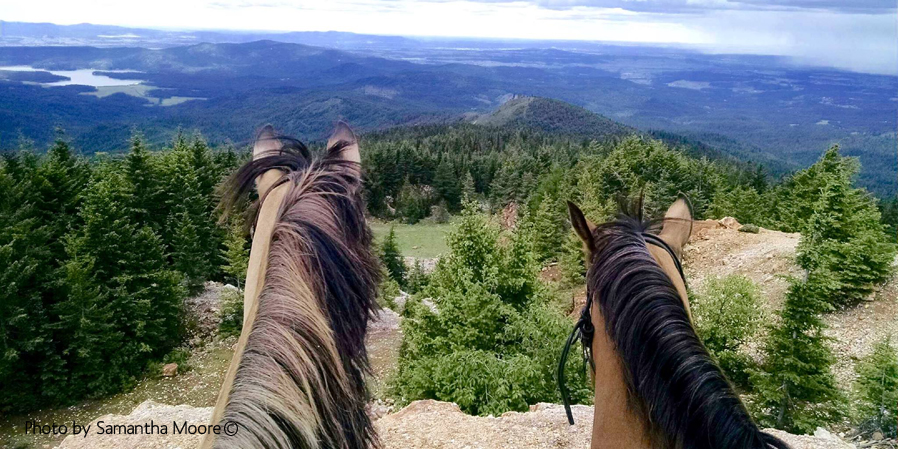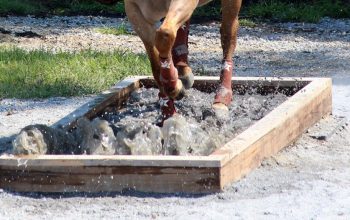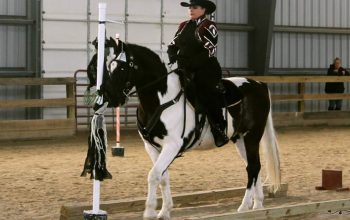 By Holly Carson
By Holly Carson
Equine Trail Sports has grown from offering 23 events in 6 states in 2013, to offering 318 events in 21 states in 2016. Equine Trail Sports welcomes rides in any state wishing to host an ETS event.
Competitive trail riding just got more interesting and fun. For the first time, riders can compete the same way they learn, adding skills as acquired. With Equine Trail Sports, the rider can choose the level of difficulty they attempt at each obstacle. Does your horse love water? Choose level 3, the highest level of difficulty for a water obstacle. If you can’t jump a fallen log, showcase how well you can walk over the log by choosing level 1 for a jump obstacle. Customize your ride experience to best fit you and your equine on that day, at that time. Does your horse have more difficulty on cold and windy days? Adjust your competition level attempted during those weather conditions to maximize your fun and safety – one obstacle at a time.
“What I find the most exciting and fun about Equine Trail Sports events, is that I get the opportunity to choose skill levels that match what I am learning with my horse. I started out this season unable to side pass. As I’ve improved my side pass, I’ve been able to choose higher difficulty levels for obstacles which incorporate side passing.”
All three Equine Trail Sports co-founders were computer nerds in past careers, making possible the simple-to-use scoring program which manages riders’ choices, and places riders in Advanced, Intermediate or Novice skill brackets. Simply put, riders who choose an average obstacle difficulty that day of 2.5 or greater are placed in the Advanced Bracket. Riders who choose an average obstacle difficulty of 1.5 or less are placed in the Novice Bracket. Riders who choose an average obstacle difficulty between 1.5 and 2.5 fall into the Intermediate Bracket.

“Initially it was hard for me to understand how a competitor could win an Intermediate Bracket and be allowed to choose some advanced obstacles in the competition. Then I ‘got it’, and realized, the best intermediate rider acquires advanced skills as they progress to becoming an advanced rider. The ETS competition format is designed to mirror how an equine and rider team naturally learn and develop. Equine Trail Sports is the only competitive trail ride organization I know of, where a competitor can ‘ramp up’ difficulty in actual competition on their road to becoming a better team. As an intermediate rider, I love the fact that I can add more and more advanced obstacles in my ride competitions. Further, the ‘CHOICE’ format gave my Mom, who had never competed before ETS, the confidence she needed to enter her first event. Now she’s hooked!”
“Equine Trail Sports trusts me to choose the right obstacle difficulty levels for me and my horse at that time. I love that I can ride without having my obstacle choices criticized by Equine Trail Sports or other riders. I can go to the ride and compete as hard as I can, or I can choose a more leisurely experience, and both are equally OK as far as Equine Trail Sports is concerned. If I just want to have fun, or my horse is coming off an injury, or I have had a tough time with family, or I am recovering from an illness, I am in control of how I ride that day, and ETS supports my choices! I LOVE it!”
Rider choice notwithstanding, Equine Trail Sports encourages riders to try their hardest. ETS awards more performance points for higher skill level placement. Ribbons get better and better with the higher skill placement. ETS applies a degree of difficulty factor to scores for obstacles requiring more skill. Ride hosts are encouraged to give better prizes to winners in the higher skill brackets. These incentives combine to encourage riders to try their hardest when competing.
All records are maintained on-line for every rider and equine. Members can view their performance history in almost unlimited ways, courtesy of the computer nerd backgrounds of the ETS founders. ETS tracks how many riders each competitor outperforms, tracks performance points, maintains mileage records, stores average obstacle scores, and more. A member’s statistics are accumulated across all horses ridden, and each equine’s statistics are accumulated regardless of how many riders compete with that equine.

“Equine Trail Sports recognizes rider achievement in more ways than any other competitive trail organization to which I’ve belonged. I can earn lifetime awards, annual awards, tournament awards, and event awards. On my ‘SCORES’ page, I can sort what I’ve done so many ways. I can view my horse results separately as well.”
Riders experience the Equine Trail Sports motto, “Ride for Fun, Ride to Learn” during each event’s awards ceremony. Each Judge shares with the group the criteria the judge used to judge the obstacle, and the judge offers tips for improvement. During “Judges’ Shout Out”, individual riders are recognized for special achievements by each obstacle judge. It may be that the judge wishes to recognize a rider who experienced a ‘train wreck’, but kept composed, or the judge may wish to recognize a rider that showed amazing skills.
Tournaments are a great source of “Ride for Fun”. Tournaments can be set up by Equine Trail Sports, event managers, organizations, or a group of friends. ETS tools allow tournament organizers to choose the time-frame and customize the tournament parameters. The ETS Northwest Region has set up a regional tournament with a fun-filled exciting finals event scheduled for October 2016.
POWER TO THE RIDE MANAGER aka EVENT HOST. An ETS event host has the power to compose their event using any combination of pasture, arena, or trail which best utilize the features of that event’s location. For example, if a location has three miles of beautiful trail, the host can include those 3 miles in the ETS event. Event types include: Trail Challenge – a competition that includes any combination of pasture, arena, and at least 5 miles of trail. Obstacle Course – a competition that includes any combination of pasture, arena, and up to 4 miles of trail. Recreation Ride – not a competition, casual trail riding for fun or for fund raising.
 Individuals, equine organizations, private ranches, ride venues, clubs, and charities are encouraged to consider hosting an Equine Trail Sports event. Learn more about hosting at https://www.equinetrailsports.com/manage_event/
Individuals, equine organizations, private ranches, ride venues, clubs, and charities are encouraged to consider hosting an Equine Trail Sports event. Learn more about hosting at https://www.equinetrailsports.com/manage_event/
—————————————————————————————————————
To read the complete article please visit the July Issue of We Ride Sport and Trail Magazine >>




